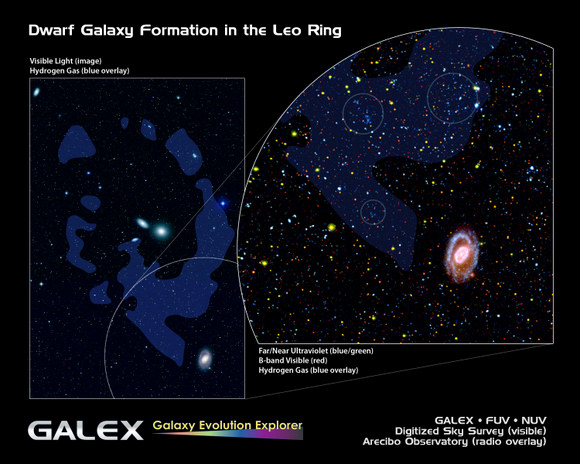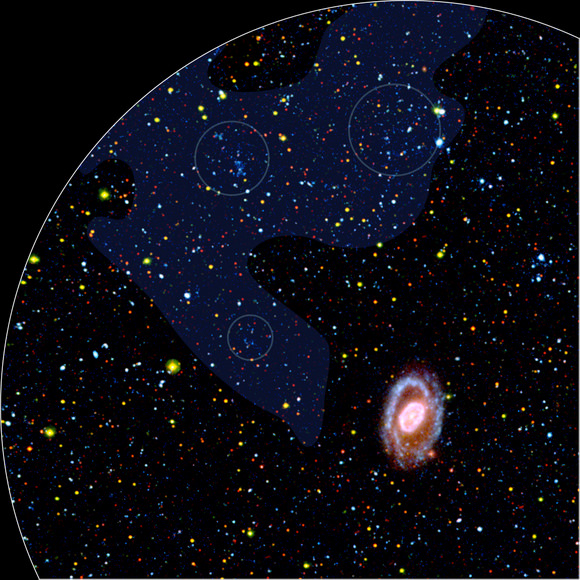[/caption]
Apparently, dwarf galaxies can spring out of thin air.
Astronomers using NASA’s Galaxy Evolution Explorer have spotted unexpected new galaxies in the constellation Leo that appear to be forming out of nothing more than pristine gas, probably leftover from the early universe. The gas lacks both dark matter and metals — previously thought to be building blocks for galaxy formation.
Dwarf galaxies are relatively small collections of stars that often orbit around larger galaxies like our Milky Way. Though never seen before, the researchers say this new type of dwarf galaxy may be common throughout the more distant and early universe, when pristine gas was more pervasive. Their discovery appears in this week’s issue of the journal Nature.
The newly described dwarf galaxies are in the Leo Ring, a huge cloud of hydrogen and helium that traces a ragged path around two massive galaxies in the constellation Leo. The cloud is thought likely to be a primordial object, an ancient remnant of material that has remained relatively unchanged since the very earliest days of the universe. Identified about 25 years ago by radio waves, the ring cannot be seen in visible light.
“This intriguing object has been studied for decades with world-class telescopes operating at radio and optical wavelengths,” said lead study author David Thilker of Johns Hopkins University in Baltimore. He added that no stars were ever seen in the gaseous regions before.
“But when we looked at the ring with the Galaxy Evolution Explorer, which is remarkably sensitive to ultraviolet light, we saw telltale evidence of recent massive star formation. It was really unexpected. We are witnessing galaxies forming out of a cloud of primordial gas.”
Our local universe contains two large galaxies, the Milky Way and the Andromeda galaxy, each with hundreds of billions of stars, and the Triangulum galaxy, with several tens of billions of stars. It also holds more than 40 much smaller dwarf galaxies, which have only a few billion stars. Invisible dark matter, detected by its gravitational influence, is a major component of both giant and dwarf galaxies with one exception — tidal dwarf galaxies.
Tidal dwarf galaxies condense out of gas recycled from other galaxies and have been separated from most of the dark matter with which they were originally associated. They are produced when galaxies collide and their gravitational masses interact. In the violence of the encounter, streamers of galactic material are pulled out away from the parent galaxies and the halos of dark matter that surround them.
Because they lack dark matter, the new galaxies observed in the Leo Ring resemble tidal dwarf galaxies, but they differ in a fundamental way. The gaseous material making up tidal dwarfs has already been cycled through a galaxy. It has been enriched with metals — elements heavier than helium — produced as stars evolve. “Leo Ring dwarfs are made of much more pristine material without metals,” Thilker said. “This discovery allows us to study the star formation process in gas that has not yet been enriched.”
Large, pristine clouds similar to the Leo Ring may have been more common throughout the early universe, Thilker said, and consequently may have produced many dwarf galaxies yet to be discovered that also lack dark matter.
Source: Caltech



With more advanced larger land based and space orbiting scopes, there may be far more
dim dwarf galaxies than we can imagine in our neighborhood of our large Milky Way, Andromeda galaxy-perhaps there are many thousands of gathering of a perhaps a thousand stars type K,M separate and independent from other mini ‘galaxies’ , but like a school of small fish near a hugh sea bass or other large fish, these ‘mini galaxies’
will be ‘swallowed’ up many at a time all the time by the big ones, our Milky Way and Andremeda Galaxy—actually, nothing wrong with this arrangement as there is ‘safety in numbers’ or ‘great to be part of the big boys’.
If these dwarf galaxies formed from truly primordial gas, might their stars be representative of the long-sought Population III stars? Spectroscopic & photometric follow-up of these nearby, DM-less systems should prove interesting.
Isn’t it obvious that this is how galaxies formed in the first place?
The Leo Ring appears to be an object exactly the same as SN 1987A and is thus an ancient object, yes, perhaps larger but is probably a long dead galaxy that has evolved and destabilised.
I would posit that the only primordial gas that’s floating around is the gas in the brains of mainstream astronomers. A bunch of door knobs, all of them.
Anyone who is familiar with Arp’s excellent work on Quasars would be able to give you the instant answer as to where these little baby galaxies came from, many years ago. They were ejected from the cores of the huge galaxies very close by.
But, as usual we have these hot-air- bag astronomers all aglow with a new fangled explanation that is pure fiction. Morons.
Yikes! Comparisons of this fascinating observation to supernovae remnants in the Large Magellanic Cloud and Chip Arp’s ‘galactic ejection’ hypothesis seem a bit premature, at best. There does seem to be some wiggle room in the press release( That the Leo Ring MIGHT be comprised of unprocessed primordial gas & previous observations SUGGEST that there is little DM in the Leo Ring ). Obviously these assertions must be scrutinized with follow up observations. But this announcement, if confirmed, should be of great interest to astronomers studying Dark Matter and those who study galaxy formation. Also, co-author Barry Madore collaborated with Halton Arp on a number of papers and their catalog of Southern peculiar and unusual galaxies-no ‘moron’ here. BTW, anyone have a link to the full paper published in Nature?
You know, I’m all for reasonable debate over the origins of various objects we have in the sky above us that at times can have some ambiguous origins. However, to start throwing around name-calling terms like “door knobs”, “hot-air-bag astronomers”, and “morons” is not only insulting, but it detracts from useful discussion.
If the ejected core hypothesis is valid, I want to see some intelligent discussion on it from its proponents. I want to see talk on that idea on the level of Stephen Hawking, not Ann Coulter.
Sorry, just saying.
You’re right, I shouldn’t have called them door knobs and morons. Ignoramouses will suffice.
You read Arp and then come back to me about why I should not be impatient with any more talk from mainstream mandarins.
Dark Matter is what is in the core of the cerebellum of mainstream astronomical brain matter. Trust me, it is a dead end explanation just like string theory and every other attempt of conjuring up (bad) science.
People like Arp have been black-listed, railroaded and vilified ONLY because they had observational proof that mainstream conclusions were bunk. In short, the proof is not in discussion and elegant math, it is observations and Arp has it nailed shut.